
Prajakta Palav is an Indian artist living and working in Bombay. Along with her studio practice the artist is running workshops and collaborative projects with the community. A ‘home maker’ studying the ‘system makers’, Prajakta Palav brings attention to all the gestures and objects shaping everyday life activities and creating the conditions for people to live together. As a city where layers of history accumulate, where cultural diversity is resembled by the closeness of people coming from all around India, Bombay and its suburbs are the ground of a multitude of personal memories. Those are pulled out from the everyday routine by a project the artist initiated a few months ago, called Happy Living.
Link to the Happy Living Facebook Page
Titles of the works reproduced (from the top, left to right),
inspired by the names of Bombay's suburbs:
Dharavi, Bandra koliwada
Mahim, Bhandup
Bhandup, Dharavi
Acrylic on canvas, dimensions vary
Image of the pamphlet of the Happy Living project
Titles of the works reproduced (from the top, left to right),
inspired by the names of Bombay's suburbs:
Dharavi, Bandra koliwada
Mahim, Bhandup
Bhandup, Dharavi
Acrylic on canvas, dimensions vary
Image of the pamphlet of the Happy Living project
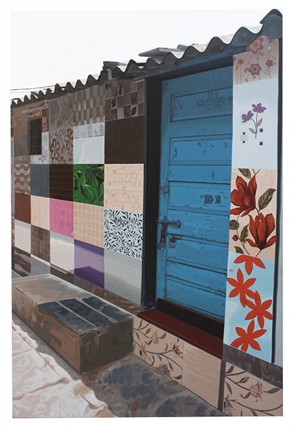
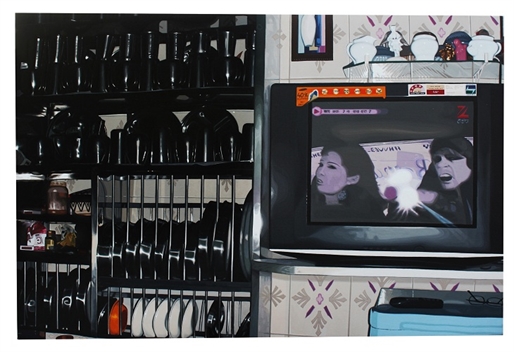
FZ: Happy Living is a project you are running in parallel to your studio practice, which you describe as meditative and ritualistic. I guess this is related to both a mental and manual work you produce when painting or creating objects. In your studio practice you are attaching importance to create meaningful and sometimes magical objects and paintings resulting from a strong philosophical inspiration. Happy Living extends your artistic reflections in a collaborative way, collecting people stories about their living memories. What moved you to develop this kind of project?
PP: I like to read Indian philosophers and saints. I like to get engaged with people who work with education. My concern towards my daughter and my family, city and city people and children motivated me to develop this kind of projects. In my studio I could sense a strong act for 'killing'. This killing is like slow poisoning, without traces... Whitewashing the traces of killing. This idea is very painful for me.
So Happy Living is an attempt to relive and conserve traces of life that are being killed. What are the reasons of this killing?
The main reason is the redevelopment happening in Bombay. We are spending lot of money, not on education and agriculture in rural areas but investing in city development, machines and weapons. Indians have a very strong background of craft, people have rich practice in meditative acts. One just can’t grab versatility of people here. The places where I am working, every house smells differently, every house looks differently. They are not like cubes in buildings. These places are like fairy land. It’s amazing to see how these places are evolved magically. Instead of destroying them we must preserve them. Sadly, within four or five years these livings will be destroyed for the sake of development.
PP: I like to read Indian philosophers and saints. I like to get engaged with people who work with education. My concern towards my daughter and my family, city and city people and children motivated me to develop this kind of projects. In my studio I could sense a strong act for 'killing'. This killing is like slow poisoning, without traces... Whitewashing the traces of killing. This idea is very painful for me.
So Happy Living is an attempt to relive and conserve traces of life that are being killed. What are the reasons of this killing?
The main reason is the redevelopment happening in Bombay. We are spending lot of money, not on education and agriculture in rural areas but investing in city development, machines and weapons. Indians have a very strong background of craft, people have rich practice in meditative acts. One just can’t grab versatility of people here. The places where I am working, every house smells differently, every house looks differently. They are not like cubes in buildings. These places are like fairy land. It’s amazing to see how these places are evolved magically. Instead of destroying them we must preserve them. Sadly, within four or five years these livings will be destroyed for the sake of development.
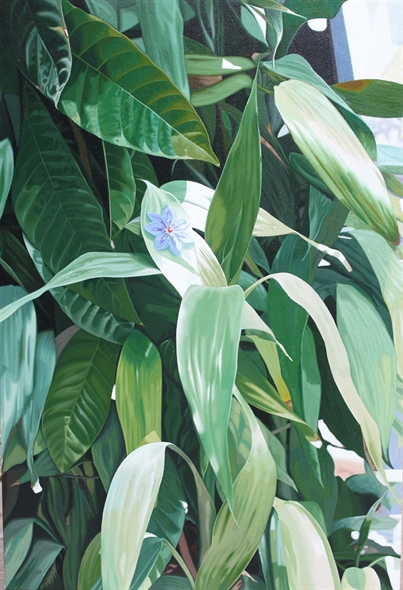
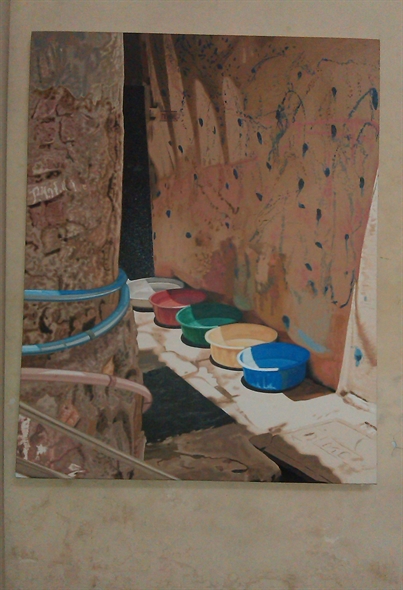
Happy Living is a work in progress, and you are working with different communities and students. Could you describe how did you develop the project?
I started painting four canvases. They are titled from the names of Bombay’s suburbs: 'Bhandup', 'Ghatkopar', 'Dharavi', 'Bandra', and look like print on canvases, they are really objective and realistic paintings. Then I made pamphlets with their printed images and Abhijeet Tamhane's short text in English and Marathi. I sit with these pamphlets at Vachanalayas and talk to people about pamphlets. Vachanalayas are small libraries, bus stop kind of structures we find at suburbs of Bombay at every 15 minutes interval. Though it is an illegal property, people have a good habit of coming here to read daily newspapers, chat and relax.
I give these pamphlets for free only on the condition that people will have to share their thoughts (memories) about the images of paintings. People can share their images by emailing or by calling me on the contact details mentioned on the pamphlet.
I have also created a Facebook page. This is the site where everyone can see shared images and activities done under the 'Happy living' title. This page would be an archive of memories and images shared by people in reaction to the 'Happy Living' pamphlet.
At the same time, I continue my studio practice by painting shared images by people.
Why did you choose the title Happy Living?
I admire Gandhi. It’s simply about living... so pure, so true! Living is very basic common thing between all of us. We all are here to live. Living is such a beautiful act in itself. Details of living are very important for me. Living is about spending time. We fill our time with daily activities. Daily acts are repetitive, like any form of nature, ritualistic, we start believing it. It makes us calm, meditative... so I trust it.
I have strong memories of my village place where we have huge living space and nature around but very few people to live in and city spaces where many migrants try to accommodate themselves in small places. When I see ads and posters of huge skyscrapers and lavish lifestyle and they call it 'Happy Living'! So here is my stand on 'Happy Living'.
I started painting four canvases. They are titled from the names of Bombay’s suburbs: 'Bhandup', 'Ghatkopar', 'Dharavi', 'Bandra', and look like print on canvases, they are really objective and realistic paintings. Then I made pamphlets with their printed images and Abhijeet Tamhane's short text in English and Marathi. I sit with these pamphlets at Vachanalayas and talk to people about pamphlets. Vachanalayas are small libraries, bus stop kind of structures we find at suburbs of Bombay at every 15 minutes interval. Though it is an illegal property, people have a good habit of coming here to read daily newspapers, chat and relax.
I give these pamphlets for free only on the condition that people will have to share their thoughts (memories) about the images of paintings. People can share their images by emailing or by calling me on the contact details mentioned on the pamphlet.
I have also created a Facebook page. This is the site where everyone can see shared images and activities done under the 'Happy living' title. This page would be an archive of memories and images shared by people in reaction to the 'Happy Living' pamphlet.
At the same time, I continue my studio practice by painting shared images by people.
Why did you choose the title Happy Living?
I admire Gandhi. It’s simply about living... so pure, so true! Living is very basic common thing between all of us. We all are here to live. Living is such a beautiful act in itself. Details of living are very important for me. Living is about spending time. We fill our time with daily activities. Daily acts are repetitive, like any form of nature, ritualistic, we start believing it. It makes us calm, meditative... so I trust it.
I have strong memories of my village place where we have huge living space and nature around but very few people to live in and city spaces where many migrants try to accommodate themselves in small places. When I see ads and posters of huge skyscrapers and lavish lifestyle and they call it 'Happy Living'! So here is my stand on 'Happy Living'.
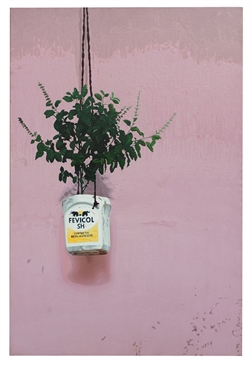
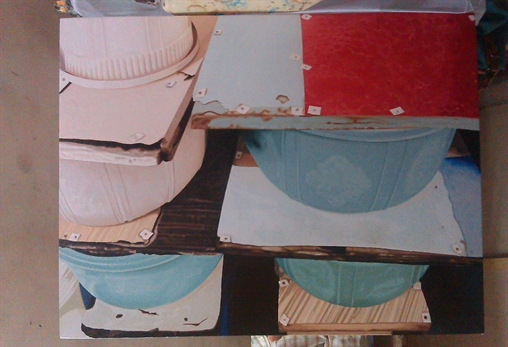
The Happy Living project has been developed both at the Vachanalayas as well as during festivals and exhibitions. Can you tell me more about your activities?
When I actually started working on this I could see more elderly people at Vachanalayas and few youngsters. I sit there with my pamphlets, show them pamphlets and ask them to look at the paintings printed on them. Then I request them to talk about those paintings. Whatever they say I note it down. Very few times they write by their own on my paper. Sometimes if they are willing to show specific location close by I go with them and take a photograph.
At the festivals or organized activities I found more young people. Some of them do visit the 'Happy living' page on Facebook and email me their found images. But the interesting thing is the visuals they share – older and younger – talk about almost similar memories.
Currently I have focused on Bhandup, one of the suburbs of Bombay, a hill which is fully covered with the living of people. People from the Maharashtra state and other parts of India migrated here around 60 years back when Bombay was at its peak at cotton industries. They are still trying to live there with limited resources. It is wonderful to see how this pattern is evolved through living and their mutual understanding about others living. There is no one to supervise or to rule. I can spend my whole life in goggling such beautiful spaces. Me and my soldiers – 15 students of architecture college – are making short films on it with mobile camera. From the last seven-eight months we are doing some site specific works there and I am also going to paint many images from that site.
They will be tiny paintings on handmade paper with gouache, so that I can carry them anywhere. The project is going very slow as we don’t want to interrupt people's routine there. Slowly people are getting use to us. When they ask us, what are we doing? We give them the 'Happy Living' pamphlet and ask about their memories and then they start...
The most beautiful thing is that now people offer us water and food, there. We haven't taken anyone's permission there and people tell everything about the space and allow us to peep into their lives! And the saddest part is, within 3-4 years this beautiful pattern will be replaced by huge, giant cubes.
How did you select the images to be painted, what is their relationship with the suburbs of Bombay?
I have done my Master in portraiture. Right from my academics I was interested in portraying people. I choose that images because I urge to become a part of it. And then my brain flies. I no longer remain me but start thinking about him. I love it! Also historically, the images are getting preserved. No bulldozer can demolish them.
The suburbs of the cities are like corners for me. Corners of mind, corners of city. We dump everything in these corners. So we always find precious things in these corners only. They are the real spaces for studying what we consume...
When I actually started working on this I could see more elderly people at Vachanalayas and few youngsters. I sit there with my pamphlets, show them pamphlets and ask them to look at the paintings printed on them. Then I request them to talk about those paintings. Whatever they say I note it down. Very few times they write by their own on my paper. Sometimes if they are willing to show specific location close by I go with them and take a photograph.
At the festivals or organized activities I found more young people. Some of them do visit the 'Happy living' page on Facebook and email me their found images. But the interesting thing is the visuals they share – older and younger – talk about almost similar memories.
Currently I have focused on Bhandup, one of the suburbs of Bombay, a hill which is fully covered with the living of people. People from the Maharashtra state and other parts of India migrated here around 60 years back when Bombay was at its peak at cotton industries. They are still trying to live there with limited resources. It is wonderful to see how this pattern is evolved through living and their mutual understanding about others living. There is no one to supervise or to rule. I can spend my whole life in goggling such beautiful spaces. Me and my soldiers – 15 students of architecture college – are making short films on it with mobile camera. From the last seven-eight months we are doing some site specific works there and I am also going to paint many images from that site.
They will be tiny paintings on handmade paper with gouache, so that I can carry them anywhere. The project is going very slow as we don’t want to interrupt people's routine there. Slowly people are getting use to us. When they ask us, what are we doing? We give them the 'Happy Living' pamphlet and ask about their memories and then they start...
The most beautiful thing is that now people offer us water and food, there. We haven't taken anyone's permission there and people tell everything about the space and allow us to peep into their lives! And the saddest part is, within 3-4 years this beautiful pattern will be replaced by huge, giant cubes.
How did you select the images to be painted, what is their relationship with the suburbs of Bombay?
I have done my Master in portraiture. Right from my academics I was interested in portraying people. I choose that images because I urge to become a part of it. And then my brain flies. I no longer remain me but start thinking about him. I love it! Also historically, the images are getting preserved. No bulldozer can demolish them.
The suburbs of the cities are like corners for me. Corners of mind, corners of city. We dump everything in these corners. So we always find precious things in these corners only. They are the real spaces for studying what we consume...
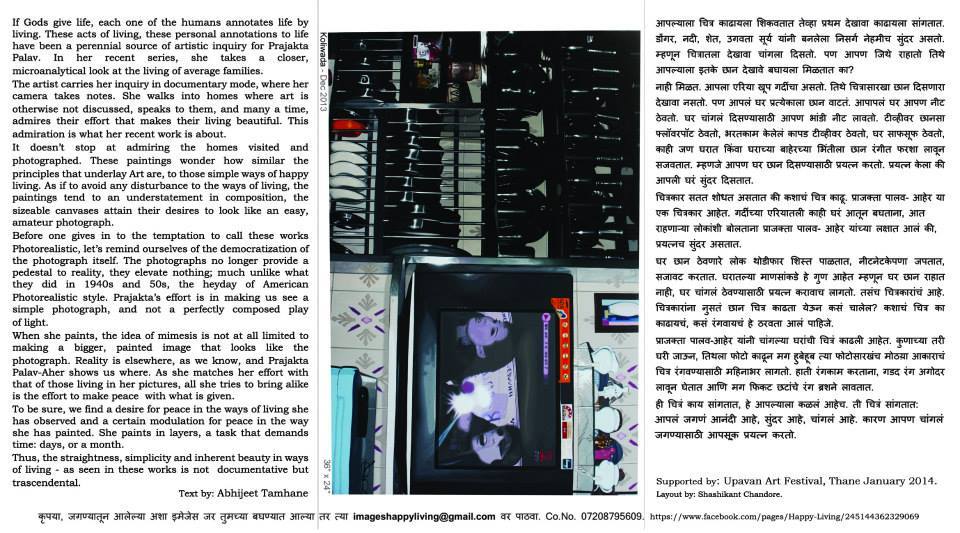
When you give the pamphlet to people, what are the three questions you ask them?
a. person's name
b. age
c. memory in reaction to pamphlet
... and what are people’s reactions?
I get multiple reactions from people. I find it interesting, ultimately they are humans. It is rare that they just ignore it, saying they don't have time. Most of the time people takes time to open up, but once they start talking about their visuals in reaction to images painted on pamphlet...they just talk and talk. They talk about their village, childhood, nature, lifestyle they had... development and governance.
Their first reaction is always through painting. They do ask how long an artist must have painted this? Are these images so important? What is special in this? Why are you doing this? What will you get out of it? Are you getting any money for doing this?
a. person's name
b. age
c. memory in reaction to pamphlet
... and what are people’s reactions?
I get multiple reactions from people. I find it interesting, ultimately they are humans. It is rare that they just ignore it, saying they don't have time. Most of the time people takes time to open up, but once they start talking about their visuals in reaction to images painted on pamphlet...they just talk and talk. They talk about their village, childhood, nature, lifestyle they had... development and governance.
Their first reaction is always through painting. They do ask how long an artist must have painted this? Are these images so important? What is special in this? Why are you doing this? What will you get out of it? Are you getting any money for doing this?